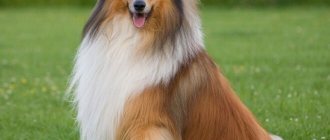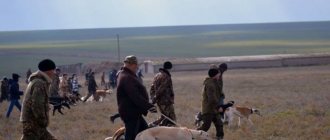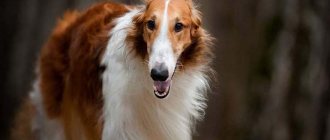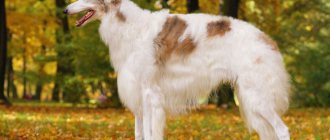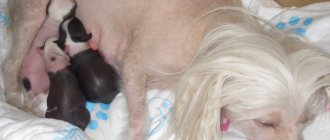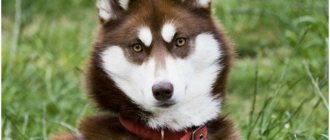A signal is given to the owner only after the prey is captured. This feature, coupled with its size, made the Deerhound the best baiting dog.
History of the breed
Until the 19th century, the breed gained its popularity. It was used not only by avid hunters to get easy prey, but also by representatives of the nobility, with its help they showed their status and importance.
Later, several representatives were taken to England, where the breed slowly won the love of people. It was also actively bred in America, but due to the lack of deer, its role changed. Here she scared away coyotes.
Later, the breed began to experience a crisis. The decline in the number of deer and the advent of firearms almost completely eliminated the Deerhound from the life of Scotland and America. There were so few deer in England that hunting them was simply banned. Because of this, everyone switched to hares, and small dogs coped with them.
By the mid-19th century, the breed was on the verge of extinction, but it was saved. The world's first kennel for breeding these greyhounds was created, and a little later a breed standard appeared, which established it in the world community.
This is one of the rarest and most expensive types of dogs; it is widespread only in Scotland. In Russia the circumstances are even worse. Currently there is only one Moscow nursery breeding this breed. But I am glad that the number of private breeders is increasing, albeit slowly.
Many people find similarities between the Deerhound and the Irish Wolfhound. There are 2 possible explanations for this. First, until the 19th century it could have been one breed, which later split. Secondly, Wolfhounds could become a very rare breed and Scottish greyhounds began to be used for their breeding, so their external features were transferred to them, but this theory is not accepted by most dog handlers.
Character and basic principles of raising a dog
Deerhounds “switch” easily. When hunting, they are surprisingly energetic and do not feel tired - they are always ready for a long run and a throw that will put an end to an exciting hunt.
When hunting, Deerhound dogs are very active and energetic.
At home, these greyhounds are lazy, calm and surprisingly sweet. Their presence, despite their size, is completely invisible. Dogs are able to lie down for several hours and bliss out in idleness.
Scottish greyhounds are very sensitive to the condition and mood of the owner. They treat children and all family members with great love and care.
They practically do not bark and are not suitable for protection - they are very loyal to all strangers. Guests coming to the house are often pointedly ignored.
Advantages of the breed:
- very smart;
- are well trained;
- are true;
- balanced and quick to switch;
- passionate hunters;
- not at all aggressive towards people;
- patient;
- do not bark without a reason;
- they love children very much.
Disadvantages of the breed:
- not a security guard;
- hard to bear loneliness;
- difficult to cope with the change of owner;
- The hunter's instinct is paramount.
The Deerhound is always calm and good-natured if he is in his owner’s home. But when hunting, it changes. This is his element.
At home, deerhounds sleep a lot and are almost invisible, despite their enormous size.
Does not require special training, mastering basic commands is enough (obedience, “City Dog” course). He learns easily, quickly remembers commands and carries them out quite quickly for his size.
Description
The coat is mostly grey. There is an admixture of light or even completely white hair. On the face it is very hard, but closer to the back and belly it becomes soft and silky.
Weight is about 35-36 kg for girls and 44-45 for boys. Height from 70 and from 75 respectively.
This is a very athletic dog. Loves running and chasing. When hunting during a chase, it can reach speeds of up to 50 km/h. In the forest it is much smaller, since the dog is not agile and has a high risk of crashing into one of the trees. He always shows very high results in competitions and tournaments.
The average lifespan of a dog is about 10-12 years, but with proper care, a healthy diet and exercise, it can live for a year or more.
Characteristics and breed standard
The Scottish Greyhound or Deerhound is a large, muscular, slender dog with a build similar to a Greyhound.
Height at withers: males minimum 76 cm, females minimum 71 cm Weight: 36.5-45.5 kg
Color: bluish-gray, fawn, sandy-red, shades of gray and brindle. White markings on the toes, chest, and tip of the tail are acceptable.
- The hair on the body is bristly, long (hair length is up to 10 cm). On the chest and belly the fur is softer; on the muzzle it creates a mustache and beard.
- Square or elongated body. The legs are long and straight.
- The head is elongated, but proportional to the body, with straight lines, with a smooth transition from the forehead to the muzzle, and strong jaws.
- Acceptable eye color is dark brown.
- The ears are small, hanging on cartilage, and set high. When the dog is calm, he pulls them back or presses them to his head.
- The color of the nose is black, and in fawn-blue dogs it is blue.
- The long tail is lowered when at rest, sometimes curved. When moving, the dog raises it, but not higher than the level of the back.
Character
Despite its appearance and general menacing nature, the dog is very friendly and loving to its owners. Although he can be simply restless during a walk, at home he is a lazy and always sleepy couch potato.
He is good with children and may even love them, but you should not get a Deerhound if you have a very small child. Don't worry, he won't hurt him intentionally, but due to his clumsiness, he can easily knock the child down by simply turning around sharply. Gets along with dogs of its own size, but does not treat small ones well. Sooner or later he will perceive them as prey and begin pursuit.
If you think that such a giant can be a good watchman, then you are deeply mistaken. Due to his melancholic nature, he is not capable of attacking or neutralizing anyone. Moreover, he will not even warn about the arrival of uninvited guests; he prefers to ignore all strangers.
They are very willful, so they need a person who, from childhood, will keep them under control. Otherwise, you simply will not be able to restrain his power, and he has plenty of it. The Deerhound must unquestioningly carry out all your commands and clearly know its place.
Education and training
In the process of raising and training a puppy, the following goals are pursued: To teach obedience and unquestioning obedience. This is important because it is difficult to keep an adult dog on a leash.
Accustom him to his own place, otherwise the dog will take a comfortable chair or sofa.
Teach your pet not to react to birds and animals on the street. Otherwise, the dog will run away and start chasing the prey.
Training is not difficult, because by nature they are obedient and intelligent dogs. During training, they are given different tasks - deerhounds do not like monotony. They are trained to run and get used to cycling, coursing (chasing a mechanical hare), and bikejoring (towing a bicycle). The best motivation during training is a treat.
Maintenance and care
In an apartment, such a dog will not be particularly comfortable, there is nowhere to turn around. A country house is more suitable for these purposes, but it should live with you, and not in a booth or enclosure. This is a domestic dog, and will not be able to live long without a family and owner.
A minimum of 2 walks per day is required. One of them must last 1 hour or more. Let your dog off the leash; this is a vital necessity for him. If you like to ride a bike, then Deerhound will definitely have your back. I don’t think there’s even any need to talk about the fact that the dog loves hunting.
IMPORTANT
It does not tolerate heat and scorching sun very well, so when planning a walking route, give preference to cool places with shade.
Wool does not require any special care. Comb about 2-3 times a week, if this is not done tangles will appear. During shedding, you need to comb out the pile more often, otherwise your whole house will look like one continuous carpet.
Don't forget to wash your eyes, clean your ears and trim your nails. The frequency depends on your dog.
Contents of Scottish Deerhounds
The breed is suitable for keeping not in a small city apartment, but in a private house (preferably in a country house), where there is plenty of space for yard walking. But this is not enough, because dogs need to exercise a lot to stay healthy and fit. Daily jogging and physical training, lasting about an hour, is required. An ideal option if the owner loves sports, cycling or is a fan of hunting. If physical activity is not a priority in life for him, then it is better not to get a deerhound.
Despite their large size, Scots are domestic pets, and kennel keeping is not suitable for them. Dogs do not tolerate heat well, so in the summer they should spend more time in the shade outside.
Advice! If a Deerhound is purchased for use in hunting, its maintenance should be spartan.
Nutrition
Deerhounds are not picky eaters; despite their size, they do not eat much. Overfeeding a dog is dangerous for its health: stomach bloating is possible, leading to its torsion or volvulus. Feeding is carried out twice a day: morning and evening. Clean drinking water must be freely available.
Scots, like humans, require a balanced diet. Dry food must be premium. It will provide adequate amounts of nutrients, minerals and vitamins. The main thing is not to give a lot of it at one feeding.
Natural food should consist of 60% of a variety of meats (preferably raw beef), 40% of cereals (buckwheat, millet, rice), dairy products (kefir, cottage cheese) and vegetables (carrots, cabbage and herbs are healthy). Once a week, provide sea fish, removing the fins and sharp bones. Salt, eggs, and milk are added to the diet of puppies.
Dog care
The most important thing is grooming. It is combed 5-6 times a week, otherwise tangles will quickly form. Once every 2-3 months, dead hairs are plucked out around the eyes, ears and muzzle. Trimming is carried out in specialized salons. Deerhounds do not need bathing unless necessary, and they are afraid of water.
Ears require careful care. They are cleaned using special preparations. Taking care of your eyes is also a must because they are one of the indicators of health. Brushing your teeth is at the discretion of the owner, but periodically cleaning them of plaque is good for health. If the claws do not grind down on their own, they are trimmed.
Education and training
In the process of raising and training a puppy, the following goals are pursued: To teach obedience and unquestioning obedience. This is important because it is difficult to keep an adult dog on a leash.
Accustom him to his own place, otherwise the dog will take a comfortable chair or sofa.
- Photo from Instagram account beddy_whip_noodle
Teach your pet not to react to birds and animals on the street. Otherwise, the dog will run away and start chasing the prey.
Training is not difficult, because by nature they are obedient and intelligent dogs. During training, they are given different tasks - deerhounds do not like monotony. They are trained to run and get used to cycling, coursing (chasing a mechanical hare), and bikejoring (towing a bicycle). The best motivation during training is a treat.
Nutrition
You can feed him commercial food and canned food, but it’s better if you cook for him yourself. In this case, more than half of his diet should be meat. This is a very athletic breed and needs protein to stay in shape. The rest should be vegetables and cereals. Don't forget about dairy products. They are essential for maintaining a healthy metabolism.
Avoid overeating. With a calorie surplus, the dog may begin to gain weight, and this greatly affects the dog’s health.
Features of care and maintenance of the deerhound
Do not forget that this dog is a born hunter. Therefore, it needs to be raised in the most real Spartan conditions, as befits real hunting dogs. After mastering the basic commands, you need to start training. It is better to conduct them in specially designated areas, with the knowledge of the management of hunting clubs, which periodically organize such events.
If a Deerhound is purchased as a companion and a pet, it will have to be taught order from the moment it arrives in the house. The dog must know his place. Otherwise, the owner’s bed will be constantly occupied by this giant, and traces of molting will have to be collected throughout the house.
Important! Scottish greyhounds are unpretentious, but have difficulty adapting to living in apartment conditions. It would be more comfortable for them to live in the private sector, where they have the opportunity to run around to their heart's content. Unrealized energy will certainly result in torn floor coverings and damaged furniture.
The deerhound's coarse coat should be periodically brushed with a furminator.
The Deerhound's coat does not require special care, but requires thorough weekly brushing with a Furminator. You should periodically clean your eyes, ears, and shorten your claws.
The key to your pet's health will be sufficient physical activity and quality nutrition.
Deerhounds do not tolerate high temperatures well, so for walks, choose places where they will be in the shade most of the time.
Puppies are more active than adults. They are ready to play and frolic endlessly. Adult dogs are calmer, even lazy. Therefore, they gain weight easily, which negatively affects their health. Long walks without a leash are a vital necessity for this breed. Private areas and fields located away from roads, fenced with a strong fence, are suitable for these purposes.
Health
Although the dog has excellent immunity and good health, it does not live long. The oldest Deerhounds live on average up to 12 years.
...but there is a group of diseases that dogs of any age are susceptible to:
- gastric volvulus;
- thyroid diseases;
- liver pathologies;
- respiratory allergies;
- kidney problems;
- heart pathology.
To avoid this, do not neglect routine examinations at the veterinarian.
Where to buy a puppy. Price
This is a very rare breed of dog. In order to buy a Deerhound, you may need to travel to another city or even country.
In Russia, at the moment, only one nursery is registered for raising Scottish Reindeer Greyhounds. He is located in Moscow. You can try to adopt a puppy from private breeders. Their contacts can be found in the nursery or in the branches of the RKF.
The best age to purchase is 3-4 months. The Deerhound puppy is mature enough to identify its shortcomings, and does not yet have a strong understanding of the situation around it and does not become attached to anyone.
It’s difficult to tell about a baby’s future, so pay attention to his parents and general pedigree. If you do not understand such nuances, then it is better to hire an experienced dog handler. He will be able to choose the ideal option for you.
The price depends on the specific puppy and its documents. Typically, this is from 30 to 70 thousand, but in different situations the cost may vary.
Origin story
The most common version of the origin says that the Vikings once had a huge dog, which they called Ku. She was a universal animal, guarded housing, hunted, went hiking, and as a result had increased aggressiveness. Subsequently, the dogs were divided into two branches. The larger and heavier ones were used to hunt wolves and wild boars; they were called Irish wolfhounds. It is worth noting that they never grazed livestock. Lighter and faster dogs were found further north and were used to hunt deer, hence the name Deerhound or Scottish deerhound. Dogs were also taken to hunt hares and foxes.
In modern society, the use of greyhounds for their intended purpose is very difficult, especially in England and Europe, where hunting is not encouraged. The difficult situation of preserving working qualities is saved by the possibility of using a greyhound in competitions to chase a mechanical hare.
There are very few deerhounds around the world. For example, at Craft, a worldwide show, just over a hundred dogs are exhibited annually. In Russia there are only a few of them, breeders and lovers of Scottish greyhounds know all representatives of the breed by name.
For this reason, it is impossible to register a national breed club and it is very difficult to buy a puppy.
Video about the Deerhound (Scottish Deerhound) dog breed:
Reviews
Alexey: “I was looking for a dog for hunting. I already had several, so I knew what I was looking for. The purchase was problematic, but all the effort was worth it. This is an amazing, kind dog. Gets along great with the whole extended family.”
Oksana: “I have had many dogs throughout my life. The Deerhound is something unique. I have never seen a dog being thrown so violently from one extreme to another. At home he is alone, on the street he is different, kind to his family, callous to strangers. An incredible dog, you rarely see such love for an owner.”
Description of the Deerhound breed (breed standard)
The first thing that distinguishes a Deerhound dog is its appearance. He cannot be called a cute or cute dog. He looks like a long, sullen giant who came down to us from medieval frescoes.
An animal of this breed is very large and takes an honorable 9th place among the thirty largest dogs in the world. The weight of an adult deerhound can reach 50 kilograms or more. The height at the withers is 0.76 m for males and, accordingly, 0.71 m for females.
